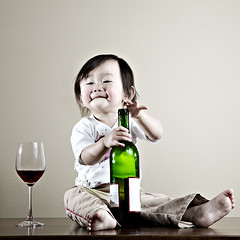 We interrupt our regularly scheduled coverage of this month's wines from Friuli to bring you some other Italian wine news from Tuscany. ("Wine Pour," by KatieW)
We interrupt our regularly scheduled coverage of this month's wines from Friuli to bring you some other Italian wine news from Tuscany. ("Wine Pour," by KatieW)I recently attended a tasting of Tuscan wines at the invitation of domaine547 (you can read more about our wine adventure here), and it was a wonderful chance for me to deepen and broaden my knowledge of wines from Italy while focusing on a single region. Sponsored by Winebow, this event had some great producers and some terrific wines were poured. Here are some of my impressions:
1. Super Tuscans may rock, but Sangiovese rules. I know that some folks love powerful Super Tuscans, with their blends of Cabernet, Merlot, and other grape varieties, but as far as I'm concerned, give me Sangiovese. Some of the Super Tuscans I tasted were indistinguishable from Bordeaux reds, others could be mistaken for Rhone wines. They were yummy, well-made, and many of the other tasters seemed to like their power and pizazz. I like my Sangioveses, thank you very much, such as the 2005 Fanti Rosso di Montalcino made with 100% sangiovese and full of aromas and flavors of plum, prune, and cherry. These are great food wines. And I've found it online for between $16 and $20.
2. Italian wine can be REALLY expensive. I was absolutely stunned to see the prices. Not that there weren't good buys (see #5) but all in all, Tuscan wines will put a dent in your wallet. and the declining dollar is not going to help. So if Tuscan wines are your thing, start saving up and economizing elsewhere because the good stuff is going to cost you--especially if it's a Super Tuscan. The 2005 Tua Rita Redigaffi, for example, while excellent, retails for between $170 and $300.
3. Leather? Yes, it's in there. If I had a lot of money, I may well put it into Brunello. If you've never had a Brunello, you owe it to yourself to have one before you die. They are some seriously sexy wines, with their luscious fruit, aromas of aged leather, and more than a hint of mystery. Some of the Brunellos that stood out for me were the 2000 Salicutti Brunello di Montalcino, with its heady aromas of blackberry and leather, pure flavors, and long finish. ($66-110), the 2003 Altesino Montosoli Brunello di Montalcino's perfumed plum blossom, lavender, and leather bottling that had beautiful silkiness and a berried palate ($138), and the 2003 Fanti Brunello di Montalcino ($80), which was also beautifully perfumed with layers of fruit, spice, and tobacco in the aromas and palate.
4. Tuscan wine varies--a lot--from vintage to vintage and maker to maker. We had the opportunity to taste different vintages of the same wine next to each other, and wines made from grapes grown close to each other by different makers. The contrasts were sharp--and alarming. Tuscan wines are not homogenized. As a buyer, you need to be aware of that and make your purchases carefully.
5. Tuscan--whites? Why, yes. One of my favorite wines from the tasting was the 2006 La Parrina Ansonica Costa dell'Argentario ($13), which had sea spray, floral, and citrus aromas and flavors. I also liked the 2006 Terre di Talamo Vento Vermentinto IGT Maremma Toscana ($17-21) which had a nice roundness in its melon and citrus flavors and a well-balanced finish.
6.There are great values to be found, but if you can buy wines that you've tasted first--or from a wine merchant whose palate you trust. Sangioveses can be a bit harsh and acidic in some vintages and in the hands of some winemakers, so go to tastings in wine shops and drink glasses of Tuscan reds in restaurants when you get the chance to find some of the names, vintages, and blends that you like. My bargain pick without question was the 2004 Castellare Chianti Classico, which had surprising depth for a wine that only costs $19-24. Notes of leather, herbs, and plum were wrapped up in a silky-textured package. Great wine, great winemaking--and a great price, too.
I had a great time at the Tuscan tasting, so thanks to domaine547 for asking me along for the ride.


































